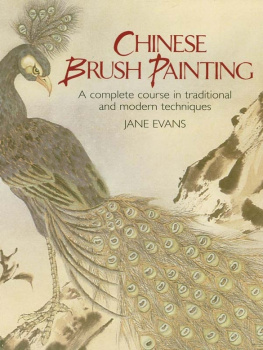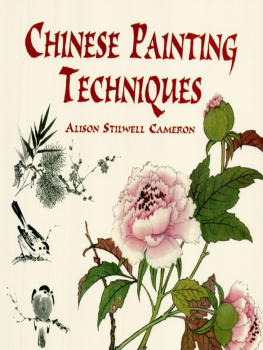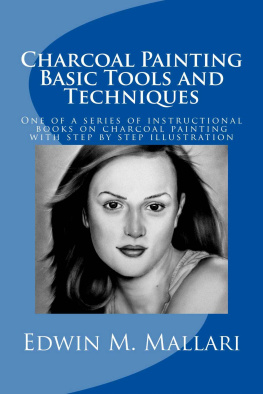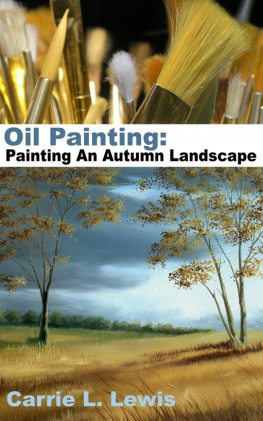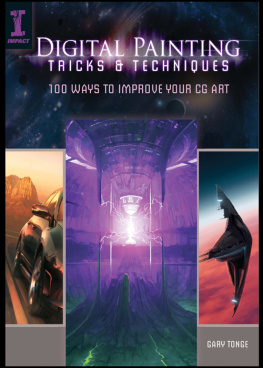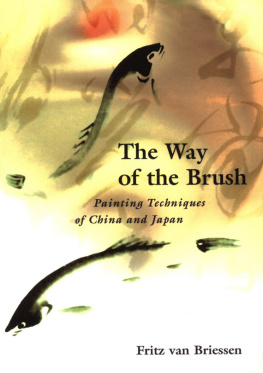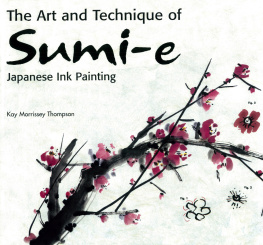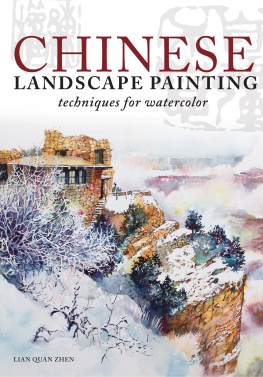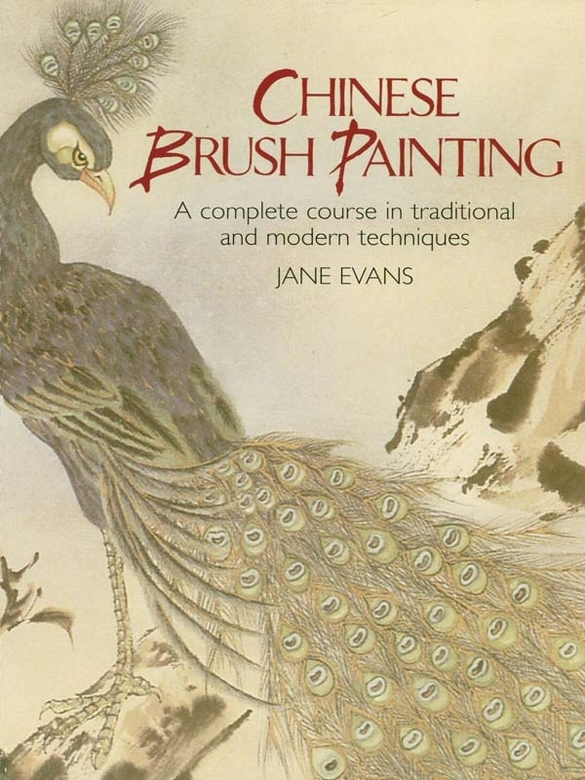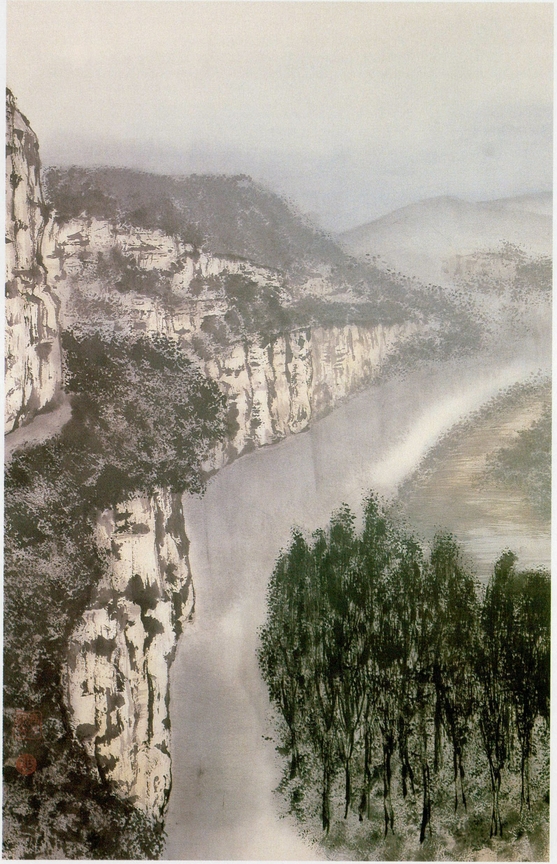First of all I must thank my teacher, Professor Chen Bing Sun, for giving me such an excellent grounding in Chinese brush painting. I should also like to thank my own students, past and present, particularly Sheena Davis, for their interest and suggestions.
The following people very kindly lent paintings as examples for the book: Miss E. J. Bagguley, Dr & Mrs A. Butterworth, Dr & Mrs C. Cherry, Mr & Mrs C. Cole, Mr & Mrs R. E. Davis, and Mrs P. Hammersley.
The discussions of history, philosophy and aesthetics owe most to three sources: Kwo Da-Weis excellent Chinese Brushwork (Allanheld & Schram/George Prior, 1981); Witold Rodzinskis very readable book The Walled Kingdom (Fontana, 1984); and a stimulating series of lectures given by Professor Michael Sullivan at Cambridge University.
Many thanks are also due to the people at Collins who worked on the book: to Cathy Gosling, Lee Griffiths, and especially Caroline Churton.
Finally, I must thank my family for their support. Thanks are particularly due to my husband for his continual help - without his persistent encouragement the book would never have been begun, let alone completed.
The River Cl, Lot, France. There is no need to feel that your paintings must use only traditional or only experimental techniques. By all means combine them as much as you like, as has been done in this painting
IN CONCLUSION
By now you have probably decided what kind of Chinese brush painting you most enjoy doing and looking at. I do recommend that you try to see as many original paintings as possible, in addition to looking at reproductions in books. A number of museums throughout Britain have good collections of Chinese paintings and there are increasing numbers of exhibitions of modern works. Looking at actual paintings rather than their reproductions is helpful in that it will give you a better idea of scale. Chinese paintings are usually rather large and this can come as a surprise. Because you will be able to see the mount as well you will get a much clearer idea of proportions, since the way a painting is mounted is often very important to the overall impact it makes. Mounts are seldom included in reproductions of paintings in books. Also, of course, books often illustrate only a detail from a painting and not the whole thing. This is particularly regrettable in the case of Chinese paintings, where space is such an important element of the composition.
Even though it is important to have followed the whole course of lessons here in sequence, there is no reason why you should not now decide to concentrate on or specialize in one or two subjects that you particularly enjoy. You may want to paint nothing but birds and flowers, or perhaps traditional landscapes. You may choose to leave traditional styles alone and experiment with newer techniques. Whatever you decide, try to paint from your own experience and to develop an individual style while remembering the rules and precepts of Chinese painting.
You may even feel that creating finished paintings is not for you and that you prefer to use your skills decoratively. For example, many shops sell Chinese paper fans to which you can add your own designs. These are made out of Chinese paper that has been heavily sized and is therefore not absorbent. You might find coping with the folds a little awkward, but this can usually be overcome by holding the area to be painted flat with one hand while wielding the brush with the other. In the case of the Chinese fans that you see on sale or in museums, however, the paper was folded and the fan spokes added after the painting was done. You can buy fan bases and circular silk fan blanks in Hong Kong and China.
You can also use your brush techniques to apply designs to pottery. Use ceramic slips before firing for best results this is not good for your brushes but produces effective designs. It is a good idea to keep a separate set of brushes for these craft uses, saving your good brushes for your serious paintings. Clothing, curtains, scarves, tablecloths, lampshades and wallpaper are all also suitable for Chinese designs, so you can see that there is an enormous range of opportunities to use your skills in Chinese brush painting to great effect.
WHERE TO SHOP
Materials and equipment
More and more art supply shops are selling materials for Chinese brush painting. Most good shops also have Japanese Teppachi colours and good-quality hake wash brushes. You should avoid, however, expensive kits containing brushes, ink stone, and ink stickthe brushes are usually indifferent and you will pay heavily over the odds for the stone and stick. Listed below is a selection of specialist shops which stock an extensive range of Chinese painting materials.
Man Lune Choon (mail order send for catalogue)
29-35 Wing Kut Street
Harvest Building
2nd Floor, Flat B
Hong Kong
Guanghwa Company
9 Newport Place
London WC2H 7JR
Tel: 01 437 3737
Falkiner Fine Papers
117 Long Acre
London WC2E 9PA
Tel: 01 240 2339
Georgina Cowdrey
23 Oaklands Road
Petersfield
GU32 2EY
Tel & Fax: 01730 300816
Email: geocow@waitrose.com
Maggie Cross
91 Village Road
Alverstoke
Hants PO12 2LE
Tel: 023 9250 2051
Oriental Arts
5 Gardner Street
Brighton BN 1 1UP
Tel: 01273 819168
GreatAr-t (Gerstaecker UK Ltd.)
Normandy House
1 Nether Street
Alton GU34 1EA
Tel: 0845 601 3333
Fax: 01420 59 3333
Email: welcome@greatart.co.uk
www.greatart.co.uk
Jacksons
1 Farleigh Place
London N16 7SX
Tel: 020 7254 0077
Fax: 020 7254 0088
www.jacksonsart.com
BIBLIOGRAPHY
I have not attempted to provide an exhaustive list of books about Chinese and Japanese painting here, including only those of which I have some personal knowledge. The first section contains details of books that I have found especially interesting or useful. In the second section I have listed a wider selection of works.
Au Ho-nien, Ink and Colour Paintings of Au Ho-nien, Art Book Co., Ltd, Taipei, 1984. A collection of works by one of the modern exponents of the Lingnam school.
Chen Shuren, The Art of Chen Shuren, Urban Council of Hong Kong, 1980. A biography of one of the founders of the Lingnam school, including examples of his works.
Gao Jianfu, The Art of Gao Jianfu, Urban Council of Hong Kong, 1981. A biography of the founding father of the Lingnam school, including examples of his works.
Gao Qifeng, The Art of Gao Qifeng, Urban Council of Hong Kong, 1981. A biography of one of the founders of the Lingnam school, including examples of his works.
Hua Junwu (ed.), Contemporary Chinese Painting, New World Press, Beijing, 1983. A selection of works by most of the important painters in China at present, together with essays about Chinese brush painting by leading Chinese authorities on the subject.
Kwo Da-Wei, Chinese Brushwork Its History, Aesthetics and Techniques, Allanheld & Schram, Monclair, 1981, and George Prior, London, 1981. The sections on history and aesthetics provide a thorough discussion of the development and philosophy of Chinese brush painting and a clear explanation of the aesthetics.
Lim, Lucy (organizer), Contemporary Chinese Painting An Exhibition from the Peoples Republic of China, The Chinese Culture Foundation of San Francisco, 1983. This exhibition catalogue contains examples of and interesting essays about contemporary Chinese painting by James Cahill, Michael Sullivan, Lucy Lim and other Chinese artists and critics.

